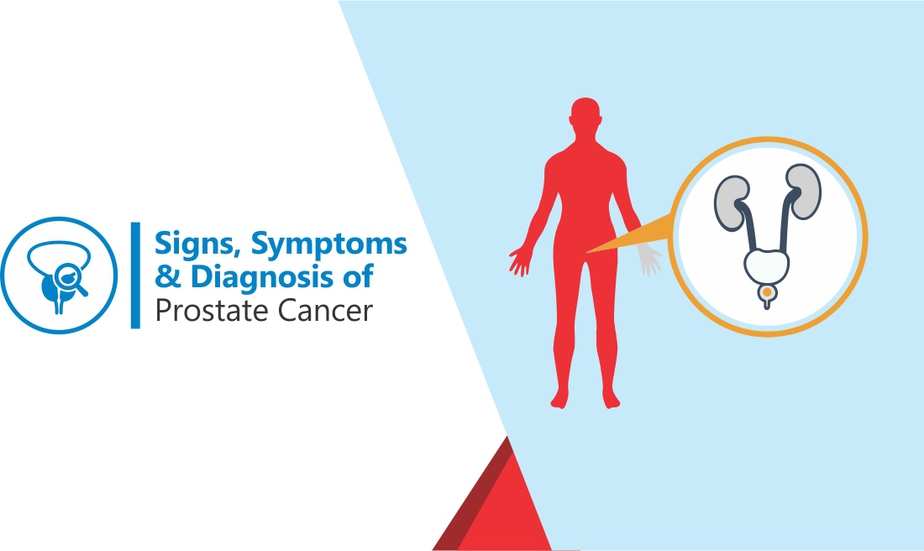Signs, Symptoms, and Diagnosis of Prostate Cancer

As the name implies prostate cancer is a type of cancer that occurs in the prostate area. The prostate is a small walnut-shaped gland in the pelvis of the male body. The prostate is responsible for producing the seminal fluid that nourishes and transports sperms. It is present next to the bladder and can be examined through a digital rectal exam.
Prostate cancer is amongst the most common types of cancers. Many prostate cancers grow at a slow pace and stay confined to the prostate gland. In this case, cancer may not cause any substantial harm. Although many prostate cancers may require minimal or even no treatment, other types are aggressive and can spread quickly.
The best chance to treat prostate cancer is when to detect cancer while it is confined to the prostate gland.
Symptoms of Prostate Cancer
Prostate cancer may not show any signs or symptoms in its early stages.
In advanced stages, prostate cancer may show signs such as:
- Trouble while Urinating
- Bland Pain in the Lower Pelvic Area
- Frequent Urination
- Blood in the Urine
- Blood in the Semen
- Painful Ejaculation
- Pain in the Lower Back, Hips, or Upper Thighs
- Erectile Dysfunction
- Loss of Appetite and Weight
Causes of Prostate Cancer
The cause of prostate cancer is not clear. There is no definitive answer to this question as no one really knows why or how prostate cancer starts.
We do know that prostate cancer happens when cells in the prostate start developing changes in their DNA. As DNA tells a cell what to do, the changes tell the cells to grow or divide more rapidly than normal cells do. These abnormal cells will continue living when other cells die. In Pakistan, an increasing number of prostate cancer cases are being reported with time. Make sure that you choose the best cancer hospital in order to make an informed decision regarding the treatment of prostate cancer.
Risks Involved with Prostate Cancer
There are several factors that increase your risk of developing prostate cancer. Some of these risk factors involve:
Older Age
As you grow old your chances of getting prostate cancer increase. The chances of getting prostate cancer are minimal in men younger than the age of 40. The most probability of getting prostate cancer is after the age of 50. As damage to the genetic material (DNA) of prostate cells is more likely to happen in men after the age of 55. These cancer cells can start growing without any control and turn into tumors.
Ethnicity
Ethnicity may seem an absurd factor at first. For reasons not yet clear, black people have by far the highest incidence of prostate cancer. Similarly, in black people, it is more likely for prostate cancer to be aggressive or advanced.
Obesity
A healthy lifestyle can prevent certain diseases. People struggling with obesity may have higher chances of getting prostate cancer. Though studies have shown mixed results, it is the general concept in most cases. In obese people, the chances are that cancer will be more aggressive or have a tendency to return even after the initial treatment of cancer.
Family History
Men with a family history of prostate cancer also face higher chances of getting affected by the disease. A man is more likely to get prostate cancer if his father, son, or brother were affected in the past. The more relatives diagnosed with prostate cancer the more are your chances.
Diagnosis of Prostate Cancer
Prostate Cancer Screening
Screening means getting tested for disease even when you don’t have any symptoms. Two screening tests are used for detecting prostate cancer. The prostate-specific antigen (PSA) blood test and the digital rectal examination (DRE) test. Both tests can be utilized to detect cancer early. These tests, however, are not without flaws. Rather than cancer, abnormal results from either test could be related to benign prostatic enlargement (BPH) or infection.
Who Should Get Screened?
Screening is recommended if you are a man:
- Between 55–69 years old
- African–American
- Have a family history of prostate cancer
Prostate Biopsy
A biopsy is a minor surgical procedure. A prostate biopsy involves removing small pieces of tissue from the prostate and examining them under a microscope. The pathologist is the physician who will examine the tissue samples for cancer cells. The only way to know for sure if you have prostate cancer is to have this procedure.
The PSA and DRE findings are used to determine whether or not a biopsy is necessary. Your doctor will also evaluate your ethnicity, biopsy history, and other health issues, as well as your family history of prostate cancer.
In most cases, an ultrasound probe is used to look at the prostate and guide the biopsy. To avoid infection, you may be given an enema and antibiotics. You will lie on your side for the test when the probe is inserted into the rectum. First, your doctor uses ultrasound to take an image of your prostate. Your healthcare professional will note the size, shape, and any anomalies of the prostate gland. He’ll also search for shadows, which could indicate malignancy. Not all prostate malignancies are visible, and not all shadows indicate the presence of cancer. A needle is then placed through the probe to numb (anesthetize) the prostate gland. The practitioner then uses biopsy equipment to remove extremely few parts of your prostate. The amount of tissue taken is determined by the gland’s size, PSA values, and previous biopsies.
If cancer cells are discovered, the pathologist will assign a “Gleason Score” to help identify the disease’s severity and risk. Blood may be seen in your ejaculate, urine, or feces after a biopsy. This should clear up fast. If not, or if you develop a fever, see your doctor.




0 Comments